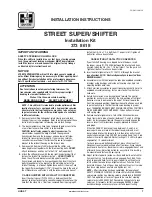
sure monitoring system (TPMS) that illuminates
a low tire pressure telltale when one or more of
your tires is significantly under-inflated. Accord‐
ingly, when the low tire pressure telltale illumi‐
nates, you should stop and check your tires as
soon as possible, and inflate them to the proper
pressure. Driving on a significantly under-inflated
tire causes the tire to overheat and can lead to
tire failure. Under-inflation also reduces fuel effi‐
ciency and tire tread life, and may affect the vehi‐
cle's handling and stopping ability. Please note
that the TPMS is not a substitute for proper tire
maintenance, and it is the driver's responsibility
to maintain correct tire pressure, even if under-
inflation has not reached the level to trigger illu‐
mination of the TPMS low tire pressure telltale.
Your vehicle has also been equipped with a
TPMS malfunction indicator to indicate when the
system is not operating properly. The TPMS
malfunction indicator is combined with the low
tire pressure telltale. When the system detects a
malfunction, the telltale will flash for approxi‐
mately one minute and then remain continuously
illuminated. This sequence will continue upon
subsequent vehicle start-ups as long as the mal‐
function exists. When the malfunction indicator is
illuminated, the system may not be able to de‐
tect or signal low tire pressure as intended.
TPMS malfunctions may occur for a variety of
reasons, including the installation of replacement
or alternate tires or wheels on the vehicle that
prevent the TPMS from functioning properly. Al‐
ways check the TPMS malfunction telltale after
replacing one or more tires or wheels on your ve‐
hicle to ensure that the replacement or alternate
tires and wheels allow the TPMS to continue to
function properly.
Flat Tire Monitor FTM
Principle
The Flat Tire display detects a tire pressure loss
while driving and issues a warning if the tire pres‐
sure has dropped.
General information
The system detects tire pressure loss on the ba‐
sis of rotation speed differences between the in‐
dividual wheels while driving.
In the event of a tire pressure loss, the diameter
and therefore the rotational speed of the corre‐
sponding wheel changes. The difference will be
detected and reported as a flat tire.
The system does not measure the actual infla‐
tion pressure in the tires.
Functional requirements
The following conditions must be met for the
system; otherwise, reliable message of a tire
pressure loss is not assured:
▷
After a tire or wheel replacement, an initializa‐
tion was performed with the correct tire infla‐
tion pressure.
▷
After the tire pressure was adjusted to a new
value, an initialization was performed.
Status display
The current status of the Flat Tire Monitor FTM
can be displayed, for instance whether the FTM
is active.
1.
"CAR"
2.
"Vehicle status"
3.
"Flat Tire Monitor"
The status is displayed.
Initialization required
An initialization must be performed in the follow‐
ing situations:
▷
After the tire inflation pressure has been ad‐
justed.
▷
After a tire or wheel replacement.
Performing initialization
When initializing, the set tire inflation pressures
serve as reference values in order to detect a flat
Seite 302
MOBILITY
Wheels and tires
302
Online Edition for Part no. 01405A38726 - VI/21
Summary of Contents for 2 SERIES COUPE
Page 2: ...Online Edition for Part no 01405A38726 VI 21 ...
Page 265: ...Cargo area CONTROLS 265 Online Edition for Part no 01405A38726 VI 21 ...
Page 277: ...Saving fuel DRIVING TIPS 277 Online Edition for Part no 01405A38726 VI 21 ...
Page 337: ...Vehicle Care MOBILITY 337 Online Edition for Part no 01405A38726 VI 21 ...
Page 341: ...Appendix REFERENCE 341 Online Edition for Part no 01405A38726 VI 21 ...
Page 357: ... BL5A3872600T 01405A38726 ue Online Edition for Part no 01405A38726 VI 21 ...
Page 358: ......
















































